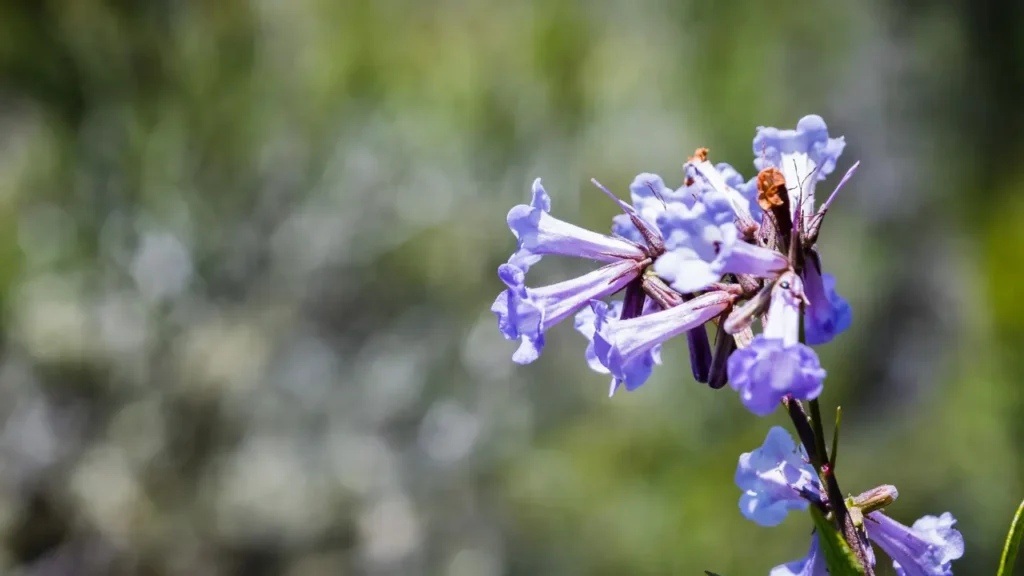Eriodictyon californicum, or Yerba Santa, is a perennial evergreen plant that grows in the western parts of the United States, especially in California, Oregon, and some parts of Nevada. Native American groups have used it for medicine for a long time, and its health benefits have been getting more attention in recent years. This article aims to thoroughly examine the chemistry, health benefits, best dose, side effects, possible drug interactions, and safe ways to use Yerba Santa as a nutritional supplement.
You May Also Like:
Should You Try CBD for Focus? Here Are the Facts.
Diamond CBD Gummies vs. Joy Organics CBD Gummies
Yerba Santa: Benefits, Dosage, Side Effects, Drug Interactions, And Other Important Information is an original (NootropicsPlanet) article.
Nature of Yerba Santa
Yerba Santa, also known as Eriodictyon californicum, is in the family Boraginaceae. It has thick, lance-shaped leaves that are sticky and made of resin. Clusters of small, tube-shaped, white to lavender flowers grow on the plant from April to June. The healing qualities of Yerba Santa come from the unique mix of bioactive compounds found in the leaves.
Health Benefits of Yerba Santa
Health of the Lungs
Native American groups have used Yerba Santa to help people cough and open their airways. Its flavonoids, like eriodictyol and homoeriodictyol, have been shown to relax smooth muscle cells in the airways, which could help relieve bronchospasm and make it easier for air to move. Tannins may also help lower mucus production and clear up congestion in the respiratory tract because of their astringent properties.
Antioxidant Properties
The flavonoids and phenolic substances in Yerba Santa are very good at fighting free radicals. These compounds can eliminate free radicals, lower oxidative stress, and protect cells from damage. These properties may help avoid chronic diseases like heart disease, neurodegenerative diseases, and some cancers.
Anti-inflammatory Properties
The anti-inflammatory effects of Yerba Santa come from its flavonoids and phenolic acids, which have been shown to change how inflammation works and how many cytokines are made. These things may help with some inflammatory diseases, like arthritis, asthma, and inflammatory bowel disease.
Effects that protect the brain
Recent studies have shown Yerba Santa’s antioxidant and anti-inflammatory benefits may help protect the brain. Eriodictyol, a flavonoid found in Yerba Santa, has been shown to protect neural cells from damage caused by oxidative stress and inflammation. This result suggests that Yerba Santa could be used to help prevent and treat neurodegenerative diseases like Alzheimer’s and Parkinson’s.

Chemistry of Yerba Santa
Flavonoids, phenolic compounds, and terpenoids comprise Yerba Santa’s varied phytochemical profile, giving the plant bioactive properties. Flavonoids are the most common and well-studied of these. They are also responsible for many of the plant’s healing benefits. Flavonoids like eriodictyol, homoeriodictyol, and chrysoeriol help give Yerba Santa its ability to fight free radicals, reduce inflammation, and open up the airways.
There is another group of bioactive parts in Yerba Santa called phenolic substances. This group includes phenolic acids and tannins. Phenolic acids like caffeic acid, chlorogenic acid, and ferulic acid are known for their ability to fight free radicals and reduce inflammation. Conversely, Tannins have tightening effects, which is why Yerba Santa has traditionally been used to treat lung problems.
Terpenoids, including monoterpenes and sesquiterpenes, are also essential substances in Yerba Santa. These chemicals give the plant its distinctive smell and may also have anti-inflammatory, antibacterial, and antiviral effects.
Physiological Mechanism of Action
The bioactive parts of Yerba Santa, primarily flavonoids, phenolic substances, and terpenoids, are responsible for how the plant works on the body. These compounds connect with different cells and molecules in the body and change the way certain physiological processes work.
System for Breathing
Flavonoids in Yerba Santa, like eriodictyol and homoeriodictyol, are mainly responsible for their bronchodilator and expectorant benefits. These chemicals ease the smooth muscle cells that line the bronchioles, making them less tight. This helps improve the flow of air and ease the signs of lung diseases like asthma and bronchitis. Tannins in Yerba Santa have astringent qualities and may also help reduce mucus production, making breathing even better.
Antioxidant Properties
Most of Yerba Santa’s antioxidant action comes from its flavonoids and phenolic compounds, which can eliminate free radicals and reduce oxidative stress in the body. By eliminating free radicals, these compounds help prevent damage to cells and may lower the chance of chronic diseases like heart disease, neurodegenerative disorders, and some cancers that are linked to oxidative stress.
Anti-inflammatory Properties
Flavonoids and phenolic acids in Yerba Santa are responsible for its anti-inflammatory effects. These chemicals change the expression and activity of enzymes and signaling molecules involved in inflammation pathways. By stopping the production of pro-inflammatory cytokines like tumor necrosis factor-alpha (TNF-) and interleukin-6 (IL-6) and encouraging the production of anti-inflammatory cytokines, these compounds can help control the body’s inflammatory reaction.
Effects that protect the brain
The antioxidant and anti-inflammatory effects of Yerba Santa are what give it its beneficial effects. For example, the flavonoid eriodictyol has been shown to keep neural cells from getting hurt by oxidative stress and inflammation. This result may be significant for neurodegenerative diseases like Alzheimer’s and Parkinson’s, where oxidative stress and inflammation play a big role in how the disease’s progression.

Optimal Dosage of Yerba Santa
The right amount of Yerba Santa to take depends on several things, such as the person’s age, health, and what they want to get out of treatment. Since there are few clinical studies on Yerba Santa, it’s hard to develop a standard dose. On the other hand, traditional use and anecdotal proof, can give some clues. People often drink Yerba Santa as a tea, which is made by putting 1 to 2 teaspoons of dried leaves into 8 ounces of hot water for 10 to 15 minutes. This mixture can be taken twice or three times a day to help with breathing, to reduce inflammation, or as an antioxidant boost.
The dose of a standardized extract may change depending on the amount of active substances in the extract. Before starting a new supplement, following the manufacturer’s directions and talking to a healthcare expert is important.
Side Effects of Yerba Santa
Most people think using Yerba Santa in small amounts and for short periods is safe. Some people, especially if they take too much, may get stomach problems like sickness, diarrhea, or stomach cramps. Also, people allergic to plants in the family Hydrophyllaceae should be careful when using Yerba Santa because cross-reactivity may happen.
As with any supplement, you should talk to a doctor before taking Yerba Santa. This is especially important for women who are pregnant or nursing, people who already have health problems, or people who take medications.
Potential Substance Interactions with Yerba Santa
Even though there isn’t much study on how Yerba Santa might interact with other drugs, some precautions can be taken based on how it works.
Blood thinners and blood clot busters
The anti-inflammatory and antioxidant benefits of Yerba Santa may improve the effectiveness of anticoagulant and antiplatelet drugs like warfarin, heparin, and clopidogrel. This could increase the likelihood of bleeding. Before using Yerba Santa with these medicines, talk to a doctor or other health care expert.
Medicines for high blood pressure
As the flavonoids in Yerba Santa may cause the blood vessels to widen, they could interact with blood pressure medicines. Using Yerba Santa with these medicines could lower your blood pressure, which could make you feel dizzy, lightheaded, or even faint. Before using Yerba Santa, people who take blood pressure medicines should talk to a doctor or nurse.
Bronchodilators
Because it has bronchodilator benefits, Yerba Santa may make bronchodilators like albuterol or salmeterol work better. However, this could cause too much excitement and bad side effects, like a faster heart rate, feeling nervous, or shaking. Therefore, you should be careful when using Yerba Santa with medicines that open up your airways.

Best Responsible Uses of Yerba Santa
To ensure that taking Yerba Santa as a nutritional supplement is safe and successful, following some rules that encourage responsible use is important. Here are some tips on how to use Yerba Santa safely and sensibly:
Talk to a healthcare provider.
Before taking any new supplement, including Yerba Santa, it is essential to talk to a doctor. This is especially true for people with health problems or who take medicines. A doctor or nurse can give advice on the right dose, possible side effects, and any necessary measures.
Use products of good quality.
Choose Yerba Santa supplements from trustworthy companies that follow good manufacturing practices (GMP). Choose goods that have been tested by a third party to ensure they are free of contaminants and contain the active ingredients they claim to have.
Follow the guidelines for how much to take.
Even though there isn’t much clinical research on the best dose of Yerba Santa, using it according to traditional guidelines and the directions from the maker can help ensure its safety and effectiveness. It is important not to take too much because that can make side effects more likely.
Keep an eye out for side effects and drug interactions
Even though Yerba Santa is usually considered safe, it is important to watch for possible side effects or interactions, especially if you use it with other medicines or supplements. If you have any bad reactions, stop using it and talk to a medical expert.
Yerba Santa:
Conclusion
While research on Yerba Santa is still limited compared to more extensively studied herbs, some studies and anecdotal evidence suggest several potential health benefits, including respiratory health, digestive health, wound healing, antioxidant, anti-inflammatory, and antimicrobial properties. Although Yerba Santa is promising in various health applications, more robust clinical research is necessary to validate its efficacy and safety for specific conditions. As with any herbal supplement, it’s essential to consult with a healthcare professional before incorporating Yerba Santa into your wellness routine, especially if you have underlying health concerns or are taking medications.

References:
- The phytochemistry and pharmacology of Eriodictyon californicum, a medicinal California plant and then link: https://www.sciencedirect.com/science/article/abs/pii/S0731708523003394
- Eriodictyol: A flavonoid compound from Eriodictyon californicum with potential neuroprotective effects and then link: https://www.sciencedirect.com/science/article/abs/pii/S0731708523003394
- Medicinal Plants of the Western United States: A Review and then link: https://www.liebertpub.com/doi/abs/10.1089/acm.2017.0426
- Yerba Santa (Eriodictyon californicum and related species) and then link: https://www.itis.gov/servlet/SingleRpt/SingleRpt?search_topic=TSN&search_value=31803
- Flavonoids: An overview and then link: https://www.sciencedirect.com/science/article/pii/S2213453016300362
Important Note: The information contained in this article is for general informational purposes only, and should not be construed as health or medical advice, nor is it intended to diagnose, prevent, treat, or cure any disease or health condition. Before embarking on any diet, fitness regimen, or program of nutritional supplementation, it is advisable to consult your healthcare professional in order to determine its safety and probable efficacy in terms of your individual state of health.
Regarding Nutritional Supplements Or Other Non-Prescription Health Products: If any nutritional supplements or other non-prescription health products are mentioned in the foregoing article, any claims or statements made about them have not been evaluated by the U.S. Food and Drug Administration, and such nutritional supplements or other health products are not intended to diagnose, treat, cure, or prevent any disease.


